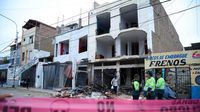On a quiet Thursday night in the city of Trujillo, northern Peru, the peace was shattered by a powerful explosion that sent shockwaves through a neighborhood already familiar with violence. The blast, which occurred on August 14, 2025, left at least 10 people injured and damaged 25 homes, according to local authorities. The event not only rattled the community but also highlighted the growing threat of organized crime and extortion that has gripped this region in recent years.
Interior Minister Carlos Malaver did not mince words when discussing the likely cause behind the explosion. He suggested that the attack could be linked to ongoing disputes between criminal groups, primarily those involved in extortion—a crime that has seen a worrying surge across Peru. "The explosion could be related to disputes between criminal groups primarily involved in extortion," Malaver stated, as reported by the Associated Press. The sense of unease was palpable as residents surveyed the damage: shattered windows, crumbling walls, and streets littered with debris.
Trujillo, a city nestled within the state of La Libertad, has long struggled with high crime rates. The recent blast, which also interrupted electric service in the area and affected an unknown number of vehicles, is just the latest in a string of violent incidents that have plagued not only this city but other parts of Peru as well. According to the state’s emergency service agency, some of those injured in Thursday’s explosion suffered burns and cuts, though officials have not released detailed information about their conditions.
As if one explosion weren’t enough, Thursday proved to be a particularly grim day for Peru. Earlier the same day, another blast was reported at a gym in the capital city of Lima. Fortunately, no injuries were immediately reported in that incident. Still, the fact that two explosions occurred within hours of each other underscored the growing sense of insecurity felt by many Peruvians.
Explosive attacks, especially those targeting small businesses, have become alarmingly common in Lima and other Peruvian cities, including Trujillo. Local media now report such incidents almost daily, painting a picture of a country where violence and intimidation are becoming part of everyday life. Public transportation has not been spared either; there have been reports of detonations inside buses, resulting in additional injuries and amplifying public fear.
The government of La Libertad has acknowledged the severity of the situation. In a statement that was both candid and unsettling, officials admitted that crime sometimes overwhelms the police force. This admission is hardly surprising given the statistics: between January and July of 2025, Peru recorded 15,989 complaints of extortion, marking a staggering 28% increase compared to the same period in 2024. These numbers, released by official sources, reflect a trend that shows no sign of slowing down.
What drives this spike in extortion and violence? Many experts point to the increasing influence of organized crime syndicates, which have found fertile ground in regions where economic opportunities are scarce and law enforcement resources are stretched thin. These groups often target small businesses and individuals, demanding payments under threat of violence. When their demands are not met—or when rival groups clash over territory—the results can be devastating, as the residents of Trujillo witnessed firsthand.
The human toll of such violence is difficult to quantify. For those injured in Thursday's explosion, the road to recovery will be long and uncertain. The psychological scars left by such a traumatic event can linger for years, affecting not only the victims but also their families and the broader community. And while the physical damage to homes and vehicles can be repaired, the sense of security that once existed is much harder to restore.
The broader implications for Peru are significant. As extortion and organized crime continue to rise, there are concerns about the impact on the country’s economy and social fabric. Businesses may be reluctant to invest in regions perceived as unsafe, while ordinary citizens may feel compelled to alter their routines or even relocate in search of safety. The government faces mounting pressure to respond effectively, both to reassure the public and to stem the tide of crime that threatens to undermine progress in other areas.
Despite these challenges, there are glimmers of hope. Community organizations and local leaders in Trujillo and elsewhere have begun to mobilize, advocating for increased police presence, better lighting in public spaces, and more support for victims of crime. Some residents have formed neighborhood watch groups, determined to take an active role in protecting their communities. These grassroots efforts, while not a substitute for comprehensive government action, demonstrate the resilience and resolve of the Peruvian people.
At the national level, authorities have pledged to crack down on organized crime and to provide additional resources for law enforcement. Interior Minister Malaver has called for greater cooperation between local, regional, and national agencies, emphasizing the need for a coordinated response to a problem that knows no boundaries. Whether these efforts will be sufficient remains to be seen, but for now, they offer a measure of hope in a landscape marked by uncertainty.
Meanwhile, the residents of Trujillo are left to pick up the pieces—both literally and figuratively. As they repair their homes and tend to the wounded, they are also grappling with questions about what the future holds. Will the violence continue to escalate, or will authorities find a way to restore order? Can the city reclaim its sense of safety, or is this the new normal?
For now, the answers remain elusive. What is clear, however, is that the events of August 14, 2025, will not soon be forgotten. They serve as a stark reminder of the challenges facing Peru and the urgent need for solutions that address both the symptoms and the root causes of crime. As the country moves forward, the eyes of the nation—and indeed, the world—will be watching to see how it responds.
In the aftermath of the explosion, one thing is certain: the people of Trujillo are determined not to let fear define their lives. Their resilience, in the face of adversity, stands as a testament to the enduring spirit of a community that refuses to be broken.




